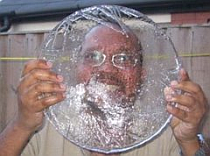Before you start playing around with your advanced modem settings, you should realize that not every modem tweak will work for everyone. There are different brands and various chipsets--proceed with caution. If in doubt, contact PC Clinic.
For Internet users who may still be on dial-up service, here is a tweak you may find particularly useful.
If you get disconnected from your ISP without warning (and too often), try adding this initialisation string. Open the Control Panel, click on the Modems icon, click your modem's Properties button, select the Connection tab, and then click the Advanced button. In the Extra settings field, enter "S10=50" (without the quotes). This might help your dial-up connections stick around for a while.
To make your dialup modem dial to your ISP faster:
In the Extra settings field, enter "S11=50" (without the quotes). You could also try "40" (the lower the number, the faster your modem will dial). Also note that if you have more than one entry in your Extra Settings field, each should be separated by a single space.
You have to enter your username and password every time you log into your ISP. However, what protocols are you using to communicate with it? Chances are, you're using a few too many. Open your DUN folder and select the 'Properties' of your Internet account. Flip to the 'Server Types' tab and make sure that 'TCP/IP' is the only network protocol selected. Before trying this tweak, check with your ISP to make sure TCP/IP is the only protocol you need for a connection. If you cleared the NetBEUI and IPX/SPX protocols, you should see your dial-up connection time decrease.
Scanning tip:
If you use a scanner, it might also be wise to have a black sheet of paper handy. Whether you're scanning text or pictures, place the black sheet behind the document. This way, you won't get as much glare or light reflection, creating crisper, richer scans.
Reducing startup programs:
How many programs do you have in your Startup group? If you're like me, not very many. I realise, however, that there are some users who have about 15-20 programs automatically launch when Windows boots up. You really only want a fraction of those to run at any given time, so instead of putting all those shortcuts in your Startup folder, why not make a folder somewhere on your hard drive and name it something (like 'Launchers'). Move all the shortcut icons out of the Windows Startup folder and into the 'Launchers' one. Then, place a 'Launchers' folder shortcut into the 'Startup' folder; it should be the only shortcut in there. This way, when Windows boots up, you'll see a small window with all your 'Startup' shortcuts displayed. You can pick and choose which ones you want to launch at that time. This way, you could pick and choose which programs you want to run when you start every Windows session.
Cursing the cursors:
For Windows users, who like to use fancy animated cursors, remember that these use extra RAM. If you are already running a PC with a small amount of RAM, restore your cursors to the default black and white set.
Want a faster shutdown?
Before Windows shuts down, it has to play a sound file. If you want Windows to shutdown faster, go to Control Panel, Sounds and Audio Devices and click the Sounds tab. Look for Exit Windows in the Program Events list and click on it. Under the Sounds bar, choose None. Of course, if you dislike the Windows Startup sound or any other you can remove them in the same way. I chose to have No Sounds.
Before you reboot Windows, remove any CD from your drive(s). You may shave a few seconds off of boot-up time!
Printer ink is expensive. Here are a few tips to reduce some costs:
· Do you HAVE to print in colour? If not, print in black.
· If your printer holds one cartridge (like some Canon), buy a black to print in black instead of relying on the colour cartridge to mix three colours to produce the black.
· Use the Draft or ‘Economy’ mode to print text, or non-presentation photos. The print quality is excellent for readability, even when I submit work to my university lecturers.
· Lighten the black intensity (saturation).
· Use Normal mode for photos, or Best mode ONLY for photos you are displaying or are extra-special to you.
· Use the Print Preview to check your document’s layout before printing. It may save you some ink and paper.
Selecting a printer:
I recommend a printer which changes the print head every time you change the cartridge. Some printers have the print heads built into a cradle in the printer. Once ink passes through these heads, any period of non-use will allow the ink to solidify and clog the system.
Buying a printer with the print head built into the cartridge can save you from buying a new printer.
(Thanks to Chris Pirillo for some of these tweaks and tips).
